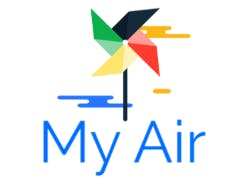Keeping air quality at safe levels is important. Studies found unacceptably high levels of carbon dioxide (CO2), formaldehyde and other volatile organic compounds (TVOC), and particle pollution in multiple indoor fitness centers. Air quality with CO2 concentration above 1000 ppm is low. 2000-5000 ppm can cause problems. TVOC up to 325 ppb considered as acceptable.
How you know that your environment, home, workplace, car, gym are safe?
Now you can make your own air quality monitor with help of the NXP Rapid IoT Prototyping Kit (SLN-RPK-NODE)
and free online NXP Rapid IoT Studio
without any software installation, coding and soldering. SLN-RPK-NODE has built-in air quality sensor CCS811. It can measure CO2 and TVOC.
As a fisrt step I recommend to get an overview of the studio with a 6 minute intro video:
1. Register a new account at https://rapid-iot-studio.nxp.com
2. Download https://github.com/vlasov01/my-air/blob/master/My%20Air.atmo to your local filesystem.
3. Create a new project in Studio by importing the downloaded file
4. Save the project in the Studio
5. Compile the project. Make sure you got "Project has been completed" message on the top. It may take 50-60 seconds.
6. Download the firmware by pressing "Program Firmware" icon.
7. Connect SLN-RPK-NODE to your computer using USB cable.
8. Switch SLN-RPK-NODE into programming mode. I prefer perform this operation by pressing the upper left and lower right buttons at the same time and waiting till its green led starts blinking. The new drive should be mounted.
7. Drop the firmware file to the newly mounted drive. The programming of the firmware should be completed in the next 10-15 seconds.
The program has several pages:
Temperature - Humidity - Pressure - Air TVOC - CO2.
You can switch between them by touching left and right side of the screen.
If TVOC level goes abouve 325 ppb than blue LED will be switched on.
if CO2 level rises above 1000 ppm then white LED will be turned on.
The LEDs will be turned off after 10 seconds.
The upper right button switches on back-light for 20 seconds.
Mobile Application
The Studio allows to connect device to a provided smartphone application without any coding.
The smartphone application visualizes data and can act as a cloud gateway.
Cloud
Data published to the cloud can be accessed from reporting tools. These analytical tools available from the NXP IoT Studio or the smartphone application.
Notes
The sensors are not calibrated. The temperature sensor is reporting a higher than actual temperature. It may be too close to other internal elements (CPU and/or battery).
The sensors may experience some level of drift. You may want to reset device if you think the values are not correct.
The internal battery has limited capacity. I was able to achieve ~3 hours of continuous work with My Air application so far.
BLE connectivity with provided Android application (December 2018 version) was not robust for a continuous data collection during my testing. This is a key limitation to use it. As cloud integration depends of this application was not able to use to full extend.
I wish
The mobile application is changing rapidly with many updates so I hope in the future versions it will be more robust from BLE connectivity perspective.
I wish the device has a better power budget so I can wear this device with me all day long.
I wish there is option to undo change in the NXP IoT Studio.
I wish sensors are already calibrated out of the box.










Comments
Please log in or sign up to comment.